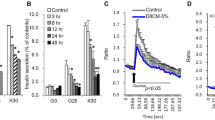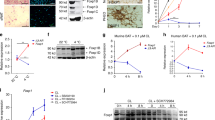Abstract
Objectives:
Hypertension is a major complication of overweight with frequently elevated aldosterone levels in obese patients. Our previous work suggests a direct stimulation of adrenal aldosterone secretion by adipocytes. Owing to aldosterone's important role in maintaining blood pressure homeostasis, its regulation in obesity is of major importance. One objective was to determine the signaling mechanisms involved in adipocyte-induced aldosterone secretion. In addition to a direct stimulation, a sensitization toward angiotensin II (AngII) might be involved. The second objective was to determine a possible adipokines-induced sensitization of human adrenocortical cells to AngII.
Design:
Human subcutaneous adipocytes and adrenocortical cells, and the adrenocortical cell line NCI-H295R were used. Adrenocortical cells were screened for signal transduction protein expression and phosphorylation. Subsequently, steroidogenic acute regulatory protein (StAR), cAMP response element-binding protein (CREB), cAMP and phosphorylated extracellular regulated kinase were analyzed by Western blot, enzyme-linked immunosorbent assay, quantitative PCR, reporter gene assay and confocal microscopy to investigate their role in adipocyte-mediated aldosterone secretion.
Results:
AngII-mediated aldosterone secretion was largely increased by preincubating H295R cells with adipocyte secretory products. StAR mRNA and StAR protein were upregulated in a time-dependent way. This steroidogenic effect was independent of the cAMP-protein kinase A (PKA) pathway as cellular cAMP was unaltered and inhibition of PKA by H89 failed to reduce aldosterone secretion. However, CREB reporter gene activity was moderately elevated. Upregulation of StAR was accompanied by ERK1/2 MAP kinase activation and nuclear translocation of the kinases. Inhibition of MAP kinase by UO126 abolished adipokine-stimulated aldosterone secretion from primary human adrenocortical and H295R cells, and inhibited StAR gene activity. Adipokines stimulated steroidogenesis also in primary human adrenocortical cells, supporting a role in human physiology and/or pathology.
Conclusions:
Adipokines induce aldosterone secretion from human adrenocortical cells and sensitization of the cells to stimulation by AngII, possibly mediated via ERK1/2-dependent upregulation of StAR activity. This stimulation of aldosterone secretion could be one link between overweight and inappropriately elevated aldosterone levels.
This is a preview of subscription content, access via your institution
Access options
Subscribe to this journal
Receive 12 print issues and online access
$259.00 per year
only $21.58 per issue
Buy this article
- Purchase on Springer Link
- Instant access to full article PDF
Prices may be subject to local taxes which are calculated during checkout







Similar content being viewed by others
References
Kopelman PG . Obesity as a medical problem. Nature 2000; 404: 635–643.
Lamounier-Zepter V, Bornstein SR, Ehrhart-Bornstein M . Mechanisms of obesity-related hypertension. Horm Metab Res 2004; 36: 376–380.
Hall JE . The kidney, hypertension, and obesity. Hypertension 2003; 41: 625–633.
Schram MT, Stehouwer CD . Endothelial dysfunction, cellular adhesion molecules and the metabolic syndrome. Horm Metab Res 2005; 37S1: 49–55.
Goodfriend TL, Egan BM, Kelley DE . Plasma aldosterone, plasma lipoproteins, obesity and insulin resistance in humans. Prostaglandins Leukot Essent Fatty Acids 1999; 60: 401–405.
Engeli S, Bohnke J, Gorzelniak K, Janke J, Schling P, Bader M et al. Weight loss and the renin–angiotensin–aldosterone system. Hypertension 2005; 45: 356–362.
Egan BM, Stepniakowski K, Goodfriend TL . Renin and aldosterone are higher and the hyperinsulinemic effect of salt restriction greater in subjects with risk factors clustering. Am J Hypertens 1994; 7: 886–893.
Licata G, Scaglione R, Ganguzza A, Corrao S, Donatelli M, Parrinello G et al. Central obesity and hypertension. Relationship between fasting serum insulin, plasma renin activity, and diastolic blood pressure in young obese subjects. Am J Hypertens 1994; 7: 314–320.
Messerli FH, Christie B, DeCarvalho JG, Aristimuno GG, Suarez DH, Dreslinski GR et al. Obesity and essential hypertension. Hemodynamics, intravascular volume, sodium excretion, and plasma renin activity. Arch Intern Med 1981; 141: 81–85.
Goodfriend TL . Aldosterone – a hormone of cardiovascular adaptation and maladaptation. J Clin Hypertens (Greenwich) 2006; 8: 133–139.
Goodfriend TL, Egan BM, Kelley DE . Aldosterone in obesity. Endocr Res 1998; 24: 789–796.
El Gharbawy AH, Nadig VS, Kotchen JM, Grim CE, Sagar KB, Kaldunski M et al. Arterial pressure, left ventricular mass, and aldosterone in essential hypertension. Hypertension 2001; 37: 845–850.
Pitt B, Zannad F, Remme WJ, Cody R, Castaigne A, Perez A et al. The effect of spironolactone on morbidity and mortality in patients with severe heart failure. Randomized Aldactone Evaluation Study Investigators. N Engl J Med 1999; 341: 709–717.
Pitt B, Remme W, Zannad F, Neaton J, Martinez F, Roniker B et al. Eplerenone, a selective aldosterone blocker, in patients with left ventricular dysfunction after myocardial infarction. N Engl J Med 2003; 348: 1309–1321.
Connell JM, Davies E . The new biology of aldosterone. J Endocrinol 2005; 186: 1–20.
Epstein M . Aldosterone as a determinant of cardiovascular and renal dysfunction. J R Soc Med 2001; 94: 378–383.
Ehrhart-Bornstein M, Hinson JP, Bornstein SR, Scherbaum WA, Vinson GP . Intraadrenal interactions in the regulation of adrenocortical steroidogenesis. Endocr Rev 1998; 19: 101–143.
Ehrhart-Bornstein M, Lamounier-Zepter V, Schraven A, Langenbach J, Willenberg HS, Barthel A et al. Human adipocytes secrete mineralocorticoid releasing factors. Proc Natl Acad Sci USA 2003; 100: 14211–14216.
Ehrhart-Bornstein M, Arakelyan K, Krug AW, Scherbaum WA, Bornstein SR . Fat cells may be the obesity-hypertension link: human adipogenic factors stimulate aldosterone secretion from adrenocortical cells. Endocr Res 2004; 30: 865–870.
Otis M, Campbell S, Payet MD, Gallo-Payet N . Angiotensin II stimulates protein synthesis and inhibits proliferation in primary cultures of rat adrenal glomerulosa cells. Endocrinology 2005; 146: 633–642.
Shah BH, Baukal AJ, Shah FB, Catt KJ . Mechanisms of extracellularly regulated kinases 1/2 activation in adrenal glomerulosa cells by lysophosphatidic acid and epidermal growth factor. Mol Endocrinol 2005; 19: 2535–2548.
Glasow A, Breidert M, Haidan A, Anderegg U, Kelly PA, Bornstein SR . Functional aspects of the effect of prolactin (PRL) on adrenal steroidogenesis and distribution of the PRL receptor in the human adrenal gland. J Clin Endocrinol Metab 1996; 81: 3103–3111.
Krug AW, Schuster C, Gassner B, Freudinger R, Mildenberger S, Troppmair J et al. Human epidermal growth factor receptor-1 expression renders Chinese hamster ovary cells sensitive to alternative aldosterone signaling. J Biol Chem 2002; 277: 45892–45897.
Krug AW, Grossmann C, Schuster C, Freudinger R, Mildenberger S, Govindan MV et al. Aldosterone stimulates epidermal growth factor receptor expression. J Biol Chem 2003; 278: 43060–43066.
Rochford JJ, Semple RK, Laudes M, Boyle KB, Christodoulides C, Mulligan C et al. ETO/MTG8 is an inhibitor of C/EBPbeta activity and a regulator of early adipogenesis. Mol Cell Biol 2004; 24: 9863–9872.
Rainey WE, Bird IM, Mason JI . The NCI-H295 cell line: a pluripotent model for human adrenocortical studies. Mol Cell Endocrinol 1994; 100: 45–50.
Lin D, Sugawara T, Strauss III JF, Clark BJ, Stocco DM, Saenger P et al. Role of steroidogenic acute regulatory protein in adrenal and gonadal steroidogenesis. Science 1995; 267: 1828–1831.
Stocco DM . Steroidogenic acute regulatory protein. Vitam Horm 1999; 55: 399–441.
Stocco DM, Clark BJ . Regulation of the acute production of steroids in steroidogenic cells. Endocr Rev 1996; 17: 221–244.
Stocco DM, Wang X, Jo Y, Manna PR . Multiple signaling pathways regulating steroidogenesis and steroidogenic acute regulatory protein expression: more complicated than we thought. Mol Endocrinol 2005; 19: 2647–2659.
Le Roy C, Li JY, Stocco DM, Langlois D, Saez JM . Regulation by adrenocorticotropin (ACTH), angiotensin II, transforming growth factor-beta, and insulin-like growth factor I of bovine adrenal cell steroidogenic capacity and expression of ACTH receptor, steroidogenic acute regulatory protein, cytochrome P450c17, and 3beta-hydroxysteroid dehydrogenase. Endocrinology 2000; 141: 1599–1607.
Fleury A, Mathieu AP, Ducharme L, Hales DB, Lehoux JG . Phosphorylation and function of the hamster adrenal steroidogenic acute regulatory protein (StAR). J Steroid Biochem Mol Biol 2004; 91: 259–271.
Reinhart AJ, Williams SC, Stocco DM . Transcriptional regulation of the StAR gene. Mol Cell Endocrinol 1999; 151: 161–169.
Seger R, Hanoch T, Rosenberg R, Dantes A, Merz WE, Strauss III JF et al. The ERK signaling cascade inhibits gonadotropin-stimulated steroidogenesis. J Biol Chem 2001; 276: 13957–13964.
Martinelle N, Holst M, Soder O, Svechnikov K . Extracellular signal-regulated kinases are involved in the acute activation of steroidogenesis in immature rat Leydig cells by human chorionic gonadotropin. Endocrinology 2004; 145: 4629–4634.
Cameron MR, Foster JS, Bukovsky A, Wimalasena J . Activation of mitogen-activated protein kinases by gonadotropins and cyclic adenosine 5′-monophosphates in porcine granulosa cells. Biol Reprod 1996; 55: 111–119.
Das S, Maizels ET, DeManno D, St Clair E, Adam SA, Hunzicker-Dunn M . A stimulatory role of cyclic adenosine 3′,5′-monophosphate in follicle-stimulating hormone-activated mitogen-activated protein kinase signaling pathway in rat ovarian granulosa cells. Endocrinology 1996; 137: 967–974.
Tian Y, Smith RD, Balla T, Catt KJ . Angiotensin II activates mitogen-activated protein kinase via protein kinase C and Ras/Raf-1 kinase in bovine adrenal glomerulosa cells. Endocrinology 1998; 139: 1801–1809.
Watanabe G, Lee RJ, Albanese C, Rainey WE, Batlle D, Pestell RG . Angiotensin II activation of cyclin D1-dependent kinase activity. J Biol Chem 1996; 271: 22570–22577.
Natarajan R, Yang DC, Lanting L, Nadler JL . Key role of P38 mitogen-activated protein kinase and the lipoxygenase pathway in angiotensin II actions in H295R adrenocortical cells. Endocrine 2002; 18: 295–301.
Suzuki J, Otsuka F, Inagaki K, Takeda M, Ogura T, Makino H . Novel action of activin and bone morphogenetic protein in regulating aldosterone production by human adrenocortical cells. Endocrinology 2004; 145: 639–649.
Manna PR, Chandrala SP, Jo Y, Stocco DM . cAMP-independent signaling regulates steroidogenesis in mouse Leydig cells in the absence of StAR phosphorylation. J Mol Endocrinol 2006; 37: 81–95.
Lin T, Wang D, Hu J, Stocco DM . Upregulation of human chorionic gonadotrophin-induced steroidogenic acute regulatory protein by insulin-like growth factor-I in rat Leydig cells. Endocrine 1998; 8: 73–78.
Manna PR, Huhtaniemi IT, Wang XJ, Eubank DW, Stocco DM . Mechanisms of epidermal growth factor signaling: regulation of steroid biosynthesis and the steroidogenic acute regulatory protein in mouse Leydig tumor cells. Biol Reprod 2002; 67: 1393–1404.
Saez JM . Leydig cells: endocrine, paracrine, and autocrine regulation. Endocr Rev 1994; 15: 574–626.
Krug AW, Ehrhart-Bornstein M . Newly discovered endocrine functions of white adipose tissue: possible relevance in obesity-related diseases. Cell Mol Life Sci 2005; 62: 1359–1362.
Lamounier-Zepter V, Rotthoff T, Ansurudeen I, Kopprasch S, Scherbaum WA, Ehrhart-Bornstein M et al. Increased aldosterone/renin quotient in obese hypertensive women. Possible role of LDL. Horm Metab Res 2006; 38: 471–475.
Acknowledgements
We thank Dr Mechthild Weiße-Lögering, Department of Plastic Surgery, Klinikum Pirna GmbH, Pirna and her team for their support in obtaining adipose tissue samples, Uta Buro for excellent technical assistance with quantitative PCR, and Jan Peychl, Max Planck Institute of Molecular Cell Biology and Genetics Dresden for technical assistance with confocal microscopy. This work was supported by grants from the Deutsche Forschungsgemeinschaft (DFG grant EH161/4–1 to MEB and SRB), a MedDrive grant (to AWK), and the Grimmke Foundation (to AWK).
Author information
Authors and Affiliations
Corresponding author
Rights and permissions
About this article
Cite this article
Krug, A., Vleugels, K., Schinner, S. et al. Human adipocytes induce an ERK1/2 MAP kinases-mediated upregulation of steroidogenic acute regulatory protein (StAR) and an angiotensin II — sensitization in human adrenocortical cells. Int J Obes 31, 1605–1616 (2007). https://doi.org/10.1038/sj.ijo.0803642
Received:
Revised:
Accepted:
Published:
Issue Date:
DOI: https://doi.org/10.1038/sj.ijo.0803642
Keywords
This article is cited by
-
Visceral fat: a bad companion for mineralocorticoid receptor overactivation
Hypertension Research (2023)
-
Management of primary aldosteronism and mineralocorticoid receptor-associated hypertension
Hypertension Research (2020)
-
Changes in morphology and function of adrenal cortex in mice fed a high-fat diet
International Journal of Obesity (2015)
-
Mineralocorticoid Receptor-Associated Hypertension and Its Organ Damage: Clinical Relevance for Resistant Hypertension
American Journal of Hypertension (2012)



